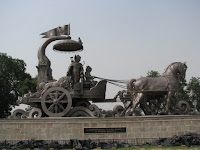 |
Statue of Krishna and Arjuna in chariot Kurukshetra (Haryana) |
The Mahabharata ends with the defeat of the Kauravas and the victory of the Pandavas. Yet, in a striking epilogue, we are told that both the Kauravas and the Pandavas ultimately ascend to Swarga-Loka—heaven. This paradoxical culmination raises a profound question: if the victors and the vanquished share the same celestial fate, what then was the war truly about? Was it a simple conflict between righteousness and unrighteousness, or something more intricate?
The answer lies in the Hindu conception of Dharma, one of the four pillars of Purushartha—the guiding aims of human life. Alongside Artha (material pursuit), Kama (desire), and Moksha (liberation), Dharma denotes righteousness, duty, and the ethical order. It is not merely a set of rules but a dynamic principle rooted in context, character, and consequence.
Contrary to conventional interpretation, the Mahabharata war was not a straightforward contest between Dharma and Adharma. In fact, both the Pandavas and the Kauravas adhered, in their own ways, to codes of conduct, ancestral obligations, and religious observances. They belonged to the same Kuru clan, shared the same lineage, revered the same gods, and upheld many of the same traditions. That is perhaps why Krishna’s Yadava clan faced a moral quandary in choosing sides.
Krishna himself opted to assist the Pandavas—not as a warrior, but as Arjuna’s charioteer. He lent his wisdom, not his weapons. His powerful army, on the other hand, fought for the Kauravas. Even Balarama, Krishna’s elder brother and a warrior of great renown, chose to abstain entirely. He refused to take a side in a war where both sides, in his eyes, were bound to Dharma. His neutrality underscores the central ambiguity of the conflict: that virtue did not reside exclusively on one side.
Thus, the Mahabharata was not a war about Dharma. It was a war within Dharma—a civilizational rupture between two righteous claims, both rooted in justice as they understood it. The true axis of the war was Kurukshetra, a term that transcends geography. Literally meaning “the field of the Kurus,” Kurukshetra symbolises not merely a battlefield in northern India, but the moral and terrestrial domain of the human condition—our world, our choices.
At the heart of the conflict was a political question cloaked in cosmic stakes: Who shall rule the earth? Who has the rightful claim to kingship? The Pandavas asserted that the land was theirs by birth and by justice; the Kauravas believed it was theirs by continuity and conquest. Neither side was willing to compromise, and so war became inevitable. But the deeper lesson of the Mahabharata is that justice, when wielded without compassion or self-restraint, leads not to harmony but to devastation.
In the end, the battlefield of Kurukshetra becomes a metaphor for life itself—a space where Dharma is constantly negotiated, never absolute. It is not the triumph of one moral order over another, but the tragic recognition that human justice is often a matter of perspective, and that righteousness, though divine in conception, is deeply human in execution.
No comments:
Post a Comment